发动机系统说明书汇编
发动机使用说明书

发动机使用说明书
一、安全须知
1.在使用发动机之前,请阅读并理解本使用说明书。
如果有任何疑问或不清楚的地方,请咨询专业人士或联系制造商。
2.在操作发动机之前,请确保您已经熟悉并掌握了操作技巧,并了解相关的安全规定。
3.在操作发动机时,请始终戴上安全帽、护目镜和防护手套,确保自身安全。
4.请确保发动机周围的工作区域清洁、干燥,并远离易燃物。
5.在启动发动机之前,请确保燃油、冷却液等液体充足,并检查电池电量是否充足。
6.在操作发动机时,请注意周围的其他人员,确保其安全。
二、发动机的启动与关闭
启动发动机:
1.将发动机的油门控制杆置于怠速位置。
2.拉起发动机启动绳,用力一拉即可启动发动机。
3.在发动机启动后,观察仪表盘上的指示灯,确保各种参数正常。
关闭发动机:
1.将发动机的油门控制杆置于怠速位置。
2.将发动机上的关闭开关置于关闭位置。
3.等待发动机冷却,然后关闭燃油阀门。
三、使用与维护
1.使用清洁的燃油,并根据制造商提供的建议加注燃油。
2.检查发动机的油位,并确保其在适当范围内。
根据使用情况补充或更换机油。
3.定期清洁气缸头和冷却风扇,确保良好的散热。
4.定期检查火花塞状态,并根据需要清洁或更换。
5.定期检查发动机皮带的松紧度,并根据需要进行调整。
6.定期检查排气管和消声器是否有损坏或堵塞。
车辆维修手册 引擎、发动机、燃油系统等说明书
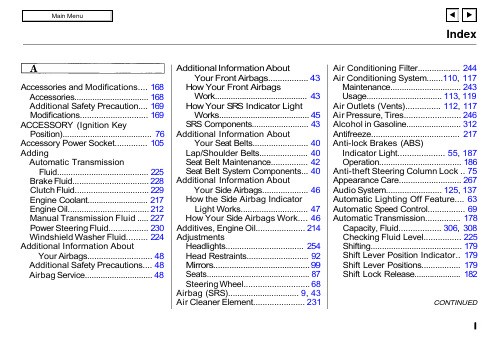
Index Accessories and Modifications (168)Accessories (168)Additional Safety Precaution (169)Modifications (169)ACCESSORY (Ignition KeyPosition) (76)Accessory Power Socket (105)AddingAutomatic TransmissionFluid (225)Brake Fluid (228)Clutch Fluid (229)Engine Coolant (217)Engine Oil (212)Manual Transmission Fluid (227)Power Steering Fluid (230)Windshield Washer Fluid (224)Additional Information AboutYour Airbags (48)Additional Safety Precautions (48)Airbag Service (48)Additional Information AboutYour Front Airbags (43)How Your Front AirbagsWork (43)How Your S R S Indicator LightWorks (45)SRS Components (43)Additional Information AboutYour Seat Belts (40)Lap/Shoulder Belts (40)Seat Belt Maintenance (42)Seat Belt System Components (40)Additional Information AboutYour Side Airbags (46)How the Side Airbag IndicatorLight Works (47)How Your Side Airbags Work (46)Additives, Engine Oil (214)AdjustmentsHeadlights (254)Head Restraints (92)Mirrors (99)Seats (87)Steering Wheel (68)Airbag (SRS)............................... 9, 43Air Cleaner Element (231)Air Conditioning Filter (244)Air Conditioning System.......110, 117Maintenance (243)Usage................................. 113, 119Air Outlets (Vents)............... 112, 117Air Pressure, Tires (246)Alcohol in Gasoline (312)Antifreeze (217)Anti-lock Brakes (ABS)Indicator Light.................... 55, 187Operation (186)Anti-theft Steering Column Lock .. 75Appearance Care (267)Audio System........................ 125, 137Automatic Lighting Off Feature (63)Automatic Speed Control (69)Automatic Transmission (178)Capacity, Fluid.................. 306, 308Checking Fluid Level (225)Shifting (179)Shift Lever Position Indicator.. 179Shift Lever Positions (179)Shift Lock Release (182)CONTINUEDIndexBatteryCharging SystemIndicator............................ 54, 292Jump Starting............................. 285Maintenance............................... 238Specifications..................... 307, 309Before Driving............................... 159Belts, Seat..................................... 8, 40Beverage Holder............................ 102Body Repair.................................... 273BrakesAnti-lock System (ABS)............ 186Break-in, New Linings .............. 160Fluid........................................... 228Light, Burned-out.............. 259, 260Parking........................................ 100System Indicator.................. 54, 294Wear Indicators......................... 185Brakes, ABSOperation.................................... 186System Indicator.................. 55, 187Braking System.............................. 185Break-in, New Vehicle .................. 160Brightness Control, Instruments (64)Brights, Headlights......................... 62Bulb ReplacementBack-up Lights........................... 260Brake Lights ...................... 259, 260Ceiling Light............................... 264Courtesy Light........................... 264Front Parking Lights................. 258Front Side Marker Lights......... 257Headlights.................................. 255High-mount Brake Light.......... 262License Plate Lights.................. 263Rear Side Marker Lights.......... 261Specifications..................... 307, 309Spotlight...................................... 264Trunk Light................................ 265Turn Signal Lights..................... 257Bulbs, Halogen. (255)Cables, Jump Starting With.......... 285Capacities Chart.................... 306, 308Carbon Monoxide Hazard .............. 49Carrying Cargo.............................. 170Cassette PlayerCare (154)Operation............................130, 151CAUTION, Explanation of.............. ii CD Changer.......................... 133, 147CD Player...............................133, 145Ceiling Light................................... 106Center Pocket................................ 105Certification Label........................ 304Chains............................................. 251Change OilHow to........................................ 214When to....................................... 202Changing a Flat Tire..................... 277Changing Engine Coolant............. 219Charging System Indicator.... 54, 292CheckingAutomatic TransmissionFluid....................................... 225Battery Condition...................... 238Brake Fluid................................. 228Clutch Fluid................................ 229Drive Belts.................................. 244Engine Coolant........................... 166Engine Oil................................... 164Fuses........................................... 297Manual Transmission Fluid ..... 227Power Steering Fluid.................230IndexChecklist, Before Driving............. 174Child Safety...................................... 20Cleaner Element, Air..................... 231CleaningAluminum Wheels..................... 269Carpeting.................................... 270Exterior....................................... 262Fabric.......................................... 270Interior........................................ 270Leather........................................ 270Seat Belts.................................... 271Vinyl........................................... 270Windows..................................... 271Climate Control System................ 117Clock, Setting the.......................... 101Clutch Fluid.................................... 229Coin Box......................................... 105CO in the Exhaust......................... 314Cold Weather, Starting in............. 176Compact Spare............................... 276Console Compartment................. 103Consumer Information*......... 318Controls, Instruments a n d........ 51CoolantAdding......................... 217Checking (166)Proper Solution.......................... 217Replacing.................................... 219Temperature Gauge.............. 59Corrosion Protection.................... 272Courtesy Lights............................. 107Crankcase Emissions ControlSystem..................... 314Cruise Control Operation............... 69Customer Relations Office (319)DANGER, Explanation of................. ii Dashboard................................... 2, 52Daytime Running Lights............. 63Dead Battery, What to Do............ 285Defects, Reporting Safety....... 322Defogger, Rear Window........... 67Defrosting the Windows....115, 123DEXRON® III AutomaticTransmission Fluid.................... 226Dimensions.............. 306, 308Dimming the Headlights................ 62DipstickAutomatic Transmission......... 225Engine Oil.. (164)Directional Signals.............64Disabled, Towing YourCar If........................................... 301Disc Brake Wear Indicators.... 185Disposal of Used Oil...................... 216DoorsLocking and Unlocking.......... 76Monitor Light..................... 56Power Door Locks....................... 76DOT Tire Quality Grading........ 310Downshifting, 5-speed ManualTransmission................. 176Drive Belts..................................... 244Driver and Passenger S a f e t y....5Driving............................................ 173Economy................... 167In Bad Weather.............. 188In Foreign Countries (313)Economy, Fuel................ 167Emergencies on the Road......... 275Battery, Jump S t a r t i n g. (285)CONTINUEDIndexEmergencies on the RoadBrake System Indicator............ 294Changing a Flat Tire................. 277Charging System Indicator...... 292Checking the Fuses................... 296Low Oil Pressure Indicator...... 291Malfunction Indicator Lamp.... 293Manually Closing Moonroof.... 295Overheated Engine................... 288Emergency Brake.......................... 100Emergency Flashers....................... 66Emissions Controls........................ 314EngineCoolant Temperature Gauge ..... 59Drive Belts.................................. 244Malfunction IndicatorLamp................................. 55, 293Oil Pressure Indicator......... 54, 291Oil, What Kind to Use............... 212Overheating................................ 288Specifications..................... 307, 309Ethanol in Gasoline....................... 312Evaporative Emissions Controls.. 314Exhaust Fumes................................ 49Expectant Mothers, Use of SeatBelts by (18)Exterior, Cleaning the (268)Fabric, Cleaning............................. 270Fan, Interior...........................110, 121Features, Comfort andConvenience............................... 109Filling the Fuel Tank..................... 161FiltersAir Cleaner................................. 231Air Conditioning........................ 244Oil................................................ 214First Gear, Shifting........................ 1825-speed Manual TransmissionChecking Fluid Level................ 2275-speed Manual TransmissionShifting the................................. 177Flashers, Hazard Warning.............. 66Flat Tire, Changing a.................... 277FluidsAutomatic Transmission........... 225Brake........................................... 228Clutch.......................................... 229Manual Transmission............... 227Power Steering (230)Windshield Washer................... 224FM Stereo RadioReception............................126, 138Folding Rear Seat............................ 93Foreign Countries, Driving in...... 313Four-way Flashers........................... 66Front End, Towing byEmergency Wrecker................. 301Fuel.................................................. 160Fill Door and Cap....................... 161Gauge............................................ 59Octane Requirement................. 160Oxygenated................................312Reserve Indicator......................... 57Tank, Filling the......................... 161Fuses, Checking the. (296)Gas Mileage, Improving................ 167Gasohol........................................... 312Gasoline.......................................... 160Fuel Reserve Indicator................ 57Gauge............................................ 59Octane Requirement................. 160Tank, Filling the.........................161IndexGas Station Procedures................. 161GaugesEngine Coolant Temperature .... 59Fuel............................................... 59Gearshift Lever PositionsAutomatic Transmission........... 1795-speed ManualTransmission.......................... 177Glass Cleaning............................... 271Glove Box.. (82)Halogen Headlight Bulbs.............. 255Hazard Warning Flashers............... 66Headlights......................................... 62Aiming......................................... 254Automatic Lighting Off............... 63Daytime Running Lights............. 63High Beam Indicator................... 57High Beams, Turning on............ 62Low Beams, Turning on............. 62Reminder Chime.......................... 62Replacing Halogen Bulbs ......... 255Turning on.................................... 62Head Restraints. (92)Heating and Cooling...................... 110High Altitude, Starting at.............. 176High-Low Beam Switch .................. 62HomeLink UniversalTransmitter.................................. 83Hood Latch..................................... 233Hood, Opening the........................ 162Horn................................................... 61Hot Coolant, Warning About........ 217Hydraulic Clutch............................ 229Hydroplaning. (189)Identification Number, Vehicle.... 304If Your Car Has to be Towed....... 301IgnitionKeys............................................... 72Switch............................................ 75Timing Control System............. 315Immobilizer System......................... 73Important Safety Precautions .......... 6Indicator Lights, InstrumentPanel.............................................. 53Infant Restraint................................ 20Inflation, Proper Tire .. (246)Inside Mirror.................................... 99Inspection,Tire.............................. 247Instrument Panel.........................3, 52Instrument Panel Brightness......... 64Interior Cleaning............................ 270Interior Lights................................ 106Introduction.. (i)Jacking up the Car......................... 278Jack, Tire........................................ 277Jump Starting (285)Keys (72)Label, Certification........................ 304Lane Change, Signaling.................. 64Lap/Shoulder Belts................... 15, 40Leaking of Exhaust into Vehicle (49)CONTINUED。
中国重汽 发动机 说明书

中国重汽发动机说明书摘要:一、引言二、中国重汽发动机的概述1.产品背景2.技术特点三、使用说明1.发动机的启动2.发动机的运行3.发动机的停止四、维护保养1.日常检查2.定期保养3.故障排除五、结束语正文:【引言】中国重汽发动机是我国自主研发生产的一款高品质发动机,广泛应用于各类重型汽车。
本说明书旨在为用户提供详细的使用和维护指导。
【中国重汽发动机的概述】【产品背景】中国重汽发动机自问世以来,凭借其出色的性能、稳定的品质和可靠的售后服务,赢得了广大用户的一致好评。
该系列发动机在设计、生产过程中充分借鉴了国际先进技术,结合我国实际情况进行优化改进,使其更符合国内用户的需求。
【技术特点】中国重汽发动机具有以下几个主要技术特点:1.高效能:采用先进的燃烧技术,提高了发动机的功率和扭矩输出。
2.低排放:尾气排放达到国家环保标准,有利于改善环境质量。
3.高可靠:采用进口原材料和精密加工工艺,保证了发动机的耐用性和可靠性。
4.低油耗:采用先进的节油技术,降低了发动机的燃油消耗。
【使用说明】【发动机的启动】1.确保发动机冷却液充足,散热器风扇正常工作。
2.检查机油油位是否在正常范围内。
3.检查空气滤清器是否清洁,燃油滤清器是否正常。
4.按下启动按钮,启动发动机。
【发动机的运行】1.在发动机运行过程中,注意观察仪表盘上的各项参数,确保发动机工作正常。
2.注意倾听发动机的声音,如发现异常响声,应立即停车检查。
3.遵守交通规则,安全行驶。
【发动机的停止】1.逐渐减少油门,让发动机转速降低。
2.轻踩刹车,减速行驶。
3.将变速器挂入空挡,发动机熄火。
【维护保养】【日常检查】1.检查发动机机油油位,如有异常,及时补充或更换。
2.检查发动机冷却液液位,确保充足。
3.检查空气滤清器和燃油滤清器是否需要更换。
【定期保养】1.每500 小时进行一次定期保养,更换机油、机油滤清器、燃油滤清器。
2.每1000 小时进行一次定期保养,检查气门间隙、更换空气滤清器。
道依茨发动机操作手册汇总
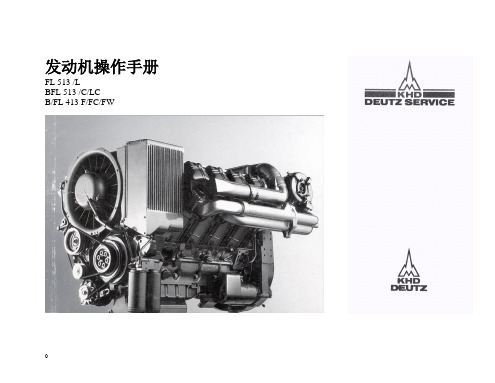
发动机操作手册FL 513 /LBFL 513 /C/LCB/FL 413 F/FC/FW●请阅读并遵照执行本操作手册中的内容,这样,你将避免故障的发生。
将生产厂商的品质保证书保存好。
注意保养发动机,使之需要时即可投入工作。
●本型号发动机的建造仅可用于供应范围中所述的领域,即发动机生产厂界定的领域,用户应根据发动机的设计目的加以使用;任何超出使用范围的应用均被认为是违背设计目的。
生产厂商对由于上述原因而造成的损坏将不承担任何责任。
涉及的风险均由用户承担。
●按照设计目的使用发动机亦意味:按照生产厂商规定的使用和维护保养的条件而使用和维护保养发动机。
发动机的使用人员必须熟悉发动机,并且了解其中涉及的风险。
●有关的事故预防规定和其他广泛接受的安全和工业卫生规定均应遵守。
●未经授权对发动机进行改动将免除生产厂商因此变动而导致的损坏的任何责任。
FL 513 /LBFL 513 /C/LCB/FL 413 F/FC/FWKHD02975818en请将发动机的系列编号填入此表内。
当发生关于用户服务、修理和备件的问题时,告诉有关人员此号码后,将有助于问题的解决(见2.1 节)。
保留全部权利。
保留为改进发动机而更改本手册中的规格数据或其他技术的权利。
无我公司的书面同意,不得以任何形式或任何手段复制本手册的任何部分。
前言前言亲爱的用户:空气冷却的DEUTZ 发动机有范围广泛的用途。
因此变型机数目较多,以适应个别用途的特殊要求。
您的发动机是按照您的用途装配的,也就是说,此手册中所述的零部件不一定都安装到您的发动机上。
在启用发动机之前,请阅读本手册,并记住各条指导。
如果您有问题,我们将乐意提供指导。
DEUTZ 国际服务部目录目录1. 概述2. 对发动机的描述2.1 型号解释2.1.1标牌2.1.2标牌的位置2.1.3发动机的系列编码2.1.4汽缸的编号2.1.5直接喷射2.1.6两级燃烧2 .2 发动机图示2.2.1 8缸NA*发动机的断面图2.2.2排气侧2.3 润滑油油路2.4 燃油系统布置图2.5 发动机冷却系统2.5.1用排气恒温器对冷却空气体积的控制2.5.2用电磁阀对冷却空气体积的控制3.发动机的操作3.1 试运转3.1.1注入机油3.1.2将机油注入油浴空气清洁器3.1.3向燃油箱注油3.1.4放气3.1.5其他准备工作3.1.6其他保养工作3.2 启动3.2.1电启动3.3 监测系统3.3.1机油压力3.3.2发动机的温度3.4 停机3.4.1机械停机的发动机*)NA = 自然进气3.4.2电气停机的发动机3.5 操作条件3.5.1冬季操作3.5.2高环境温度, 高海拔4.工作介质4.1 润润滑油4.1.1品质级别4.1.1粘度4.2 燃油4.2.1品质级别4.2.2冬季用燃油级别5.日常维修5.1 维修时间表5.2 维修示意图5.3 已完成的维修工作6.服务和维修6.1 润润滑油系统6.1.1换油周期6.1.2 更换发动机油,检查油位6.1.3 更新润润滑油滤清器6.1.4 更新旁通油滤清器滤芯6.1.5 清洁离心油滤清器6.2 燃油系统6.2.1 更新燃油滤清器6.2.2 更新重联燃油滤清器滤芯6.2.3 清洁燃油前置滤清器6.3 冷却系统6.3.1 清洁间隔6.3.2 清洁冷却系统6.4 燃烧空气清洁器6.4.1 清洁间隔6.4.2 清洁前置清洁器6.4.3 清洁油浴空气清洁器6.4.4 干式空气清洁器6.5 皮带驱动6.5.1 检查V-形皮带6.5.2 张紧或更新发电机的V形皮带6.5.3 张紧或更新空气压缩机的V形皮带6.6 调整6.6.1 检查/调整阀门间隙6.6.1.1 调整阀门间隙的示意图6.7 辅件6.7.1 电池6.7.2 三相发电机6.7.3 提升装置6.8 其他维护工作6.8.1 检查紧固件- 无增压器6.8.2 检查紧固件- 带增压器6.8.3 火焰式预热系统的功能测试7.故障排除7.1诊断图8.发动机的保存8.1保存8.1.1 保存发动机8.1.2 发动机防锈剂的清除9.技术规格数据9.1发动机技术规格和设定值9.2扭力扳手的设定值10.服务概述1概述DEUTZ 柴油发动机是历经多年研制开发的产品。
发动机系统说明书
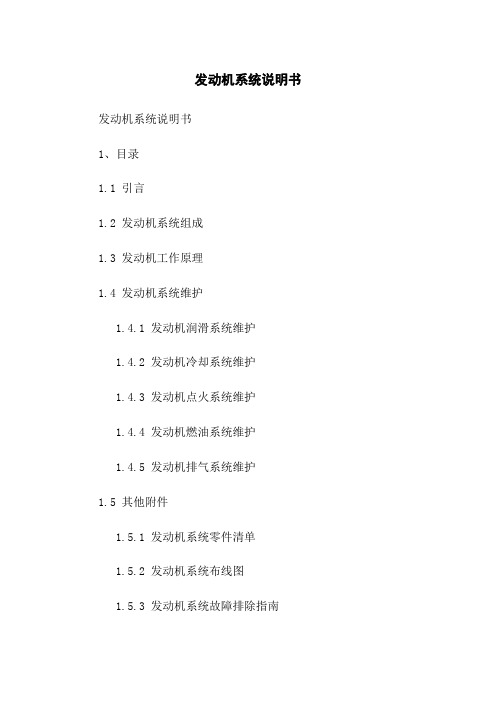
发动机系统说明书发动机系统说明书1、目录1.1 引言1.2 发动机系统组成1.3 发动机工作原理1.4 发动机系统维护1.4.1 发动机润滑系统维护1.4.2 发动机冷却系统维护1.4.3 发动机点火系统维护1.4.4 发动机燃油系统维护1.4.5 发动机排气系统维护1.5 其他附件1.5.1 发动机系统零件清单1.5.2 发动机系统布线图1.5.3 发动机系统故障排除指南2、引言本发动机系统说明书旨在提供对发动机系统的详细说明,包括其组成、工作原理以及维护方法等。
通过阅读本文档,您将了解如何正确使用和维护发动机系统,以保证其高效运行和延长使用寿命。
3、发动机系统组成发动机系统由多个关键部件组成,包括发动机本体、润滑系统、冷却系统、点火系统、燃油系统和排气系统等。
下面将对每个组成部分进行详细介绍。
3.1 发动机本体发动机本体是发动机系统的核心部分,主要包括气缸、活塞、曲轴和气门等。
它通过内燃烧过程产生动力,并将动力传递到其他系统。
3.2 润滑系统润滑系统用于提供润滑剂,以减少发动机各部件之间的摩擦和磨损。
润滑系统主要由油箱、油泵、滤清器和油冷却器等组成,确保发动机在运行过程中保持良好的润滑状态。
3.3 冷却系统冷却系统负责将发动机产生的热量排出,以保持发动机在适宜的温度范围内运行。
冷却系统通常由水泵、散热器、风扇和冷却液组成,有效控制发动机的温度。
3.4 点火系统点火系统用于在燃烧室内产生火花,点燃混合气使其爆炸,从而驱动发动机工作。
点火系统包括点火线圈、点火塞和点火控制模块等。
3.5 燃油系统燃油系统负责将燃油引入发动机进行燃烧。
燃油系统通常由燃油泵、油箱、燃油喷射器和燃油滤清器等组成。
燃油的供给需要根据发动机工况进行精确控制。
3.6 排气系统排气系统用于将燃烧产生的废气排放到大气中。
排气系统主要包括排气管、催化转化器和消声器等。
4、发动机工作原理本节将详细介绍发动机系统的工作原理。
4.1 内燃机工作循环发动机采用四冲程循环工作,包括进气冲程、压缩冲程、燃烧冲程和排气冲程。
一汽J6发动机手册(系统&原理)
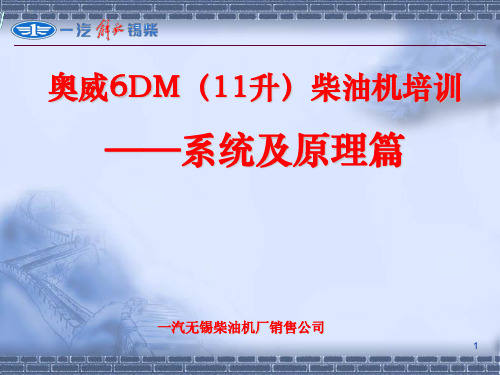
电磁阀
发动机制动系统
奥威6DM(11升)压缩制动结构设计
制动时,安装于摇臂轴上的制动 电磁阀通电,电磁阀内部油路开启, 机油从摇臂轴内副油道,通过摇臂衬 套上进油道、摇臂副油道,进入制动 器制动柱塞腔;当制动腔内机油达到 一定压力时,控制柱塞上行,单向阀 关闭,这样在制动腔充满机油,由于 机油可压缩性很小,因此整个制动腔 封闭的机油可以视为一个刚性体。在 压缩上止点前后,在制动用凸轮的作 用下,制动用排气门实现小升程的的 开启和关闭,释放出部分缸内被压缩 的气体,形成一定的真空度,从而实 现发动机的压缩、释放制动。
6DL2使用原J5P排气制动阀的单位制动功率仅17kW/L (额定点) 6DL2使用改进后的新排气制动阀的单位制动功率18.75kW/L 6DL为了得到理想的制动效果,需要配合使用改进后的新排气制动阀。 必须注意:如果不采用发动机制动,不能使用该排气制动阀!!!新排气制动阀如 果和普通发动机配合使用,将提高排气背压,超过6DL发动机的许用值,造成发动 机损坏! 6DN可以使用与原来相同的排气制动阀。
摇臂衬套上进油 孔
回位弹 簧
发动机制动系统
发动机制动 控制油进油 单向阀 制动柱塞 控制阀 锁紧螺母 调整螺栓
A B
发动机制动 小凸台 排气摇臂 压球座总 成
排气凸轮
摇臂滚轮
排气摇臂
排气门顶块
排气门桥
发动机制动系统
发动机制动小凸台
谢 谢 大 家!
46
发动机制动系统
发动机制动系统
一、为什么要使用发动机制动装置
Service brakes wear much faster once hot
And, they become less effective as they heat up.
德尔福发动机管理系统技术手册

MT20EMS系统技术手册目录第一章系统介绍第二章58齿同步逻辑及MAPCID 第三章燃油系统第四章点火系统第五章怠速系统第六章空调控制系统第七章碳罐电磁阀控制第八章风扇控制第九章里程累计系统第十章故障诊断第一章系统介绍德尔福发动机管理系统是以德尔福MT20发动机控制模块(ECM)为核心的系统,简称为MT20发动机管理系统。
一、发动机控制模块(ECM)1.MT20发动机控制模块是德尔福专门为中国地区电喷市场开发的ECM,设计上运用了最新的电子硬件技术,并同时采用了低价位的设计结构,实现了较高的性价比。
硬件上采用了16位微处理器(CPU),具有充足的内存,高强的运算速度,可灵活定义的I/O输入输出口。
软件采用德尔福模块化C语言编写的第二代控制软件。
MT20具备了满足目前欧3法规所需的所有技术规格。
2.MT20的系统功能包括:1)速度密度空气计量法;2)闭环控制多点顺序燃油喷射(包括MAPCID压力判缸);3)无分电器直接点火,由ECM内置点火模块驱动分组点火(也可支持4缸顺序点火);4)线性EGR控制;5)步进马达怠速控制;6)爆震控制;7)空调、冷却系统控制;8)里程记忆;9)电压过高保护;10)电子防盗;11)CAN-BUS通讯接口可与自动变速箱控制模块(TCM)或ABS系统通讯。
3.MT20控制软件的特点包括:1)开放式、模块化C语言编程;2)可随时采用德尔福全球共享的,持续更新改进的软件模块图书馆;3)可采用高速串行接口(HSSI)的低价位标定工具。
4.MT20控制信号图:二、曲轴位置基准及转速测量1.系统根据58X齿信号判断曲轴位置及测量发动机转速,精确控制发动机点火及喷油正时;2.曲轴位置传感器利用58X齿测量曲轴加速度,满足EOBD失火诊断要求。
三、燃油喷射系统系统采用速度密度法,实现多点顺序喷射,每个发动机循环通过主脉宽及修整脉宽精确供油,并具有闭环控制和自学习功能。
1.硬件采用德尔福第三代喷油器,最新型油压调节器;2.系统可支持无回油系统;3.用EOBD系统时可采用后置氧传感器闭环“二次”修正,降低排放。
发动机说明书

© 2007 AB VOLVO PENTA Volvo reserves the right to make changes
目录
安全注意事项 .......................................... 操作和维护保养中的安全 注意事项..............................................
起动发动机.............................................. 起动之前 .............................................. EMS起动过程 ........................................ 酷寒环境下起动...................................... 切勿使用起动喷射液................................ 用辅助蓄电池起动 .................................
发动机说明书及使用指南(升级版)
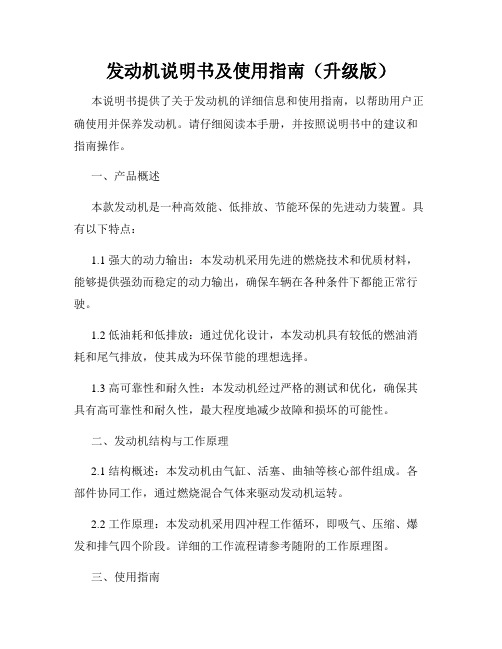
发动机说明书及使用指南(升级版)本说明书提供了关于发动机的详细信息和使用指南,以帮助用户正确使用并保养发动机。
请仔细阅读本手册,并按照说明书中的建议和指南操作。
一、产品概述本款发动机是一种高效能、低排放、节能环保的先进动力装置。
具有以下特点:1.1 强大的动力输出:本发动机采用先进的燃烧技术和优质材料,能够提供强劲而稳定的动力输出,确保车辆在各种条件下都能正常行驶。
1.2 低油耗和低排放:通过优化设计,本发动机具有较低的燃油消耗和尾气排放,使其成为环保节能的理想选择。
1.3 高可靠性和耐久性:本发动机经过严格的测试和优化,确保其具有高可靠性和耐久性,最大程度地减少故障和损坏的可能性。
二、发动机结构与工作原理2.1 结构概述:本发动机由气缸、活塞、曲轴等核心部件组成。
各部件协同工作,通过燃烧混合气体来驱动发动机运转。
2.2 工作原理:本发动机采用四冲程工作循环,即吸气、压缩、爆发和排气四个阶段。
详细的工作流程请参考随附的工作原理图。
三、使用指南请按照以下指南正确使用并保养本发动机,以确保其性能和寿命:3.1 启动发动机:3.1.1 确保车辆处于停车状态,保持空档,并将油门拉至怠速位置。
3.1.2 轻轻转动钥匙或按下启动按钮,启动发动机。
3.1.3 启动后,仔细听取发动机运行是否平稳,是否有异常声音。
如发现异常,请及时检查和维修。
3.2 行驶注意事项:3.2.1 行驶前,请确保发动机已经预热至适宜工作温度,且各项功能正常。
3.2.2 行驶时,请根据路况和速度合理加减档位,并适度控制油门。
3.2.3 长时间高速行驶后,请给发动机适当的冷却时间,以防过热。
3.2.4 注意保持发动机所需的机油和冷却液的正常水平,定期检查和更换。
3.3 维修与保养:3.3.1 定期更换机油和机滤,确保发动机正常润滑。
3.3.2 常检查和清洁空气滤清器,以保持发动机吸气通畅。
3.3.3 注意检查和更换火花塞,以保证点火正常。
发动机控制系统说明
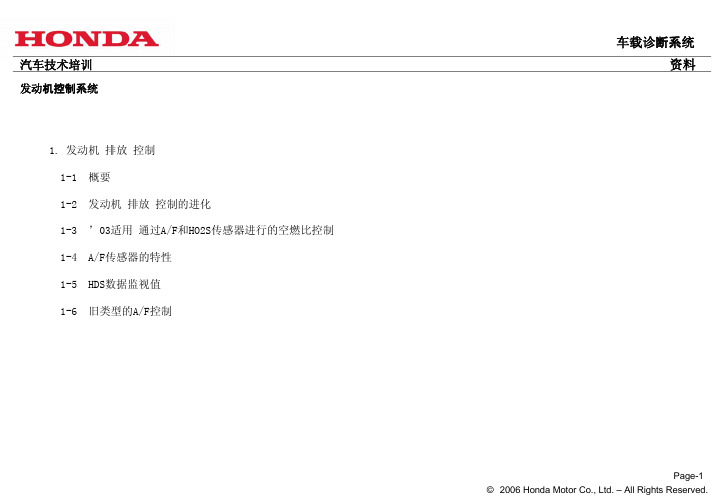
N/A
A
Page-7 © 2006 Honda Motor Co., Ltd. – All Rights Reserved.
汽车技术培训
车载诊断系统 资料
发动机控制系统
1.发动机 排放 控制 1-5. HDS数据监视值
HDS数据监视值
① AF SENSOR
0.01
mA
② AF(LAMBDA)
0.99
副HO2S传感器
※ SecondaryO2
Three Way Catalyst (TWC :三元催化器)
Page-6 © 2006 Honda Motor Co., Ltd. – All Rights Reserved.
汽车技术培训
发动机控制系统 1.发动机 排放 控制 1-5. HDS数据监视值
适用车种年份
系统
特征
’82
发动机 + 三元催化 + 主HO2S传感器
空燃比反馈控制开始
’88
采用带加热器的主HO2S传感器
主HO2S传感器的早期活性化
’92
VTEC-E 发动机中采用了 Air Fuel ratio(A/F)传感器
’95
主HO2S + 三元催化 + 副HO2S传感器
对应于稀薄空燃比发动机 对催化剂后的A/F也加以考虑的空燃比控制
汽车技术培训
车载诊断系统 资料
发动机控制系统
1.发动机 排放 控制 1-3. ’03适用 通过A/F和副HO2S传感器进行的空燃比控制
为了使得催化剂的排气净化性能得到高水平发挥,ECM/PCM随时通过催化剂前后的A/F(空燃比)来把握催化剂的状态, 进行A/F控制,使得副HO2S传感器输出保持稳定。
汽车发动机说明书

汽车发动机说明书一、引言欢迎您选择我们公司的汽车发动机产品!本说明书旨在向您提供有关我们发动机的详细信息,以帮助您更好地了解、使用和维护您的汽车。
请仔细阅读本说明书,并按照指示操作,以确保发动机的正常运行和延长使用寿命。
二、产品概述1. 发动机型号:XYZRD20002. 发动机类型:内燃机3. 排量:2.0升4. 缸径:80mm5. 冲程:100mm6. 最大功率:180马力7. 最大扭矩:200牛米8. 燃料类型:汽油9. 燃油标号:92号三、功能特点1. 高性能:本发动机采用先进的燃烧技术和优质材料,具有较高的动力输出和燃油经济性。
2. 环保节能:发动机采用清洁燃烧技术,排放低,符合国家环保标准。
3. 可靠性强:经过严格测试和质量控制,发动机具备出色的可靠性和耐久性。
4. 易于维修:发动机的结构简单,易于拆卸和维修,减少了维修成本和时间。
四、安全使用1. 本发动机只适用于汽车驱动,严禁用于其他用途。
2. 在发动机运行时,请保持引擎舱内通风良好,确保充足的氧气供给。
3. 在加注燃油时,请确保燃油标号与要求相符,并避免燃油泄漏。
4. 发动机正常运行过程中若发现异常情况(如异味、异响等),请立即停车并联系专业技术人员进行检修。
5. 禁止在发动机运行时进行维修和调整,以免发生意外。
五、使用与保养1. 发动机运行前,请检查机油、冷却液和燃油的量是否充足。
2. 发动机运行过程中,请注意观察仪表盘上的各项指标,如水温、油压等,确保处于正常范围内。
3. 定期更换机油和机油滤清器,以保证发动机的润滑性能和清洁度。
4. 定期检查发动机的零部件,如皮带、火花塞等,确保其安全可靠。
5. 发动机保养请遵循本说明书提供的保养周期,如有特殊情况,请咨询专业技术人员。
六、故障排除发动机在运行过程中可能遇到一些故障,如无法启动、冒烟等。
以下是一些常见故障的排除方法,请根据情况进行检查和处理,如仍无法解决,请联系专业技术人员解决。
性能发动机耐久性的支持系统说明书

Performance engine durability is dependent on several supporting systems including the cooling system, fuel delivery system, ignition system and oiling system.If the support systems are not adequate, poor engine performance and possible engine failure could result.OILING SYSTEM CONSIDERATIONS/ COMMON PROBLEMS•Priming the oiling system before starting a new engine is crucial to engine life. This is important on initial start-up of a new engine and if a used engine has not been run for extended periods of time.•Does the oil pan have adequate capacity? Most performance vehicles require a 7 qt. minimum capacity. All engines will benefit from increasedoil pan capacity.•Does the oil pan have proper oil control baffling for the vehicle’s braking, acceleration and cornering capabilities? Road-race cars need oil control in four directions: braking, acceleration, LH cornering and RH cornering. Drag race cars need oil controlin two directions: braking and acceleration. Baffles must be designed to keep oil over the pickup screen at all times.•Is the pickup screen the proper distance from the bottom of the oil pan? If the oil pickup screen is too close to the bottom of the oil pan, it can cause cavitation. If it is too far away, it will cause the pump to draw air and minimize lubrication capacity. The pickup screen should be located .250" to .375" from the bottom of the pan. Does the design of the screen on the pickup tube create restrictions? We have seen some pickup tube screen designs that restrict oil flow as much as 75%. Wire mesh is good. Perforated metal is usually restrictive. Measure the wire size and calculate the flow area. Most aftermarket screens have less flow area than stock screens.•If using a remote oil filter mount or oil cooler, make sure that all of the components are large enough to eliminate any restrictions to oil flow. Many Cobra replica kit cars use componentsthat are too restrictive.•Undersize oil lines commonly restrict oil flow. •The more bends/turns in an oiling system,the more restrictions are created.•Poorly designed remote filter mounts and adapters can create restrictions.•Be sure that the oil cooler flows enough oilto meet the engine’s requirements.•Never reuse a used oil cooler. Debris gets trapped and cannot be cleaned out.•Poorly designed oil filters can cause a restriction. •Many oil systems only flow one way. Connecting the remote oil filter or oil cooler lines backwards can cause engine damage/failure.IGNITION SYSTEM CONSIDERATIONS/ COMMON PROBLEMS•The ignition system must deliver a properly timed spark. There are a lot of factors that determine when the spark should be delivered. The most common factors include: compression ratio, fuel quality, fuel octane rating, combustion chamber design, engine operating temperature, power adders such as NOS or supercharger, inlet air temp, altitude and load.•Avoid too much or too little timing for your engine combination.•Avoid hooking up the vacuum advance to intake manifold vacuum instead of ported vacuum. •Avoid inductive crossfire created by improper plugwire routing. Separate plug wires on cylinders thatfire in sequence.•Improper timing can damage pistons, rod bearings,head gaskets and many other engine parts.•Typical total mechanical advance timing at4000 rpm for Ford Racing Performance Partscrate engines: 5.0L: 36° to 38°, 347/351: 34° to 36°,392/460/514: 30° to 32°.FUEL DELIVERY CONSIDERATIONS•Size of fuel pump, size of fuel line, fuel pumpplacement, fuel filter placement, fuel filter size,injector size, fuel rail size, fuel pressure, jet sizeand baffling in the fuel tank.•Does the fuel system maintain full pressureat peak engine horsepower in high gear?Altitude, air temperature and fuel characteristicsincluding quality, specific gravity and octane rating willaffect your jetting requirements. Engine efficiency andBrake Specific Fuel Consumption (BSFC) also have aneffect. Here are some examples of a Holley® 750 CFM 4V.Jett i ng Jett i ngOctane Temp. Alt i tude Front Rear94 80 F 0 ft. 81 86Aviation 100LL 80 F 0 ft. 81 84110 Race 80 F 0 ft. 78 8394 80 F 3000 ft. 76 8194 80 F 6000 ft. 73 7794 40 F 0 ft. 84 8994 120 F 0 ft. 78 83As you can see by these examples, jet requirements canvary a lot depending on fuel, altitude and temperature.Oxygenated fuels are available in some states and candramatically affect your jetting requirements. Makesure you get your jetting correct. Aviation fuel is lighterand will require richening an engine in relationship to itsrequirement with pump gas. We have found in the dynotesting of our crate engines that 1 point richer on air/fuel ratio equals only a few percent less power. Runningan engine as lean as possible produces the best powerbut also increases combustion temperatures andthe chances of engine damage.COMMON PROBLEMS WITHFUEL DELIVERY SYSTEMS•Do not mount an EFI electric fuel pump so it hasto draw fuel from the tank. This creates negativepressure in the fuel line allowing the fuel to boilat a lower temperature.•The pump must be mounted in the tankor in a location so that it is gravity fed.•If the fuel rail is too small and you have largeinjectors, this can create a pulse in the fuel railallowing fuel starvation on some cylinders.•Fuel should be pushed through the fuel filter.Pulling fuel through a filter can cause cavitation.If a filter is to be used on the inlet of a rail-mountedfuel pump, a filter rating of 160 microns MINIMUMshould be used.•It takes approx. 1/2 lb of gasoline to support1 hp. This is commonly referred to as a .5 BSFC.You should always err in the safe direction oflarger when sizing your injectors and fuel pump.COOLING SYSTEM CONSIDERATIONS/COMMON PROBLEMS•Higher horsepower requires more cooling capacity.•When the fill point of the cooling system is notthe highest point, air pockets are created. Theair pockets then create hot spots, and the hot spotspromote improper combustion, which can causeengine failure.•Improper pulley size makes the fan and water pumpturn too slow or too fast. Production water pumpsare normally run at 20% over engine speed and donot perform well over 5000 engine rpm. Underdrivepulleys generally reduce water pump speed to 85%of engine rpm and may not provide enough waterflow to cool the engine.•The radiator must have enough area to dissipatethe heat being generated by the engine.•If the fan size is too small, it will not move enoughair across the radiator so it can properly dissipatethe heat being generated. Fan shrouds increasethe effectiveness of the fan significantly.•Radiator location can affect airflow through theradiator at different vehicle speeds.FLYWHEEL, CONVERTER ANDTRANSMISSION PROBLEMS•Installing the wrong flywheel for the balance factorof the engine will cause vibration and eventuallydamage the engine.•Wrong length input shaft or “stack-up height”can force the crank forward, damaging theengine thrust bearing.•Improperly installing the torque converter can forcethe crank forward, damaging the engine thrustbearing. This is most commonly caused byimproperly locating the torque convertor drain plugin the flexplate.•If the torque converter balloons, it can force thecrank forward, damaging the engine thrust bearingand the transmission. Most high-performance torqueconverters have anti-ballooning features.•Damage to the thrust bearing can happenin seconds!MISCELLANEOUS PROBLEMSTHAT CAN DAMAGE AN ENGINE•Dropping nuts, bolts, washers or foreignmaterials down the intake. We have seen thismore than once.•Reusing an intake off an engine that had brokenparts in a cylinder. The parts can get bounced upinto the intake manifold, carburetor or air cleaner(pieces of piston or piston rings, etc.). When youput your used intake on your new engine and startit, the pieces are drawn in and damage your engine.•Bead-blasting an EFI intake. You will NEVER getall of the blasting media out. When the engine isstarted, it draws the blasting media into thecylinders, destroying the engine.•Improperly torquing fasteners when installing newparts to your engine. Over-torquing of the intakemanifold bolts to the cylinder head on 302 and351W engines can cause head gasketsealing problems.•Installing distributor gears at the incorrect height,or using gears made of the wrong material. Wehave seen this a lot on remanufactured distributorsas well as popular aftermarket manufacturersof distributor assemblies. Use cast iron gearsfor cast iron flat tappet cams, and steel gearsfor steel hydraulic roller cams.ENGINE INSTALLATION AND TUNING TIPSENGINE DYNAMOMETER TESTING BASICSTYPES OF ENGINE DYNAMOMETERSThere are many types of dynamometers for testing engines: Water Brake, Eddy-Current, Electric…just to name a few. Depending on availability and engine application, Ford Racing utilizes any of those mentioned. The basic function of each of these dynamometers (referred to as dynos from this point forward) is the same. Each applies a different method to absorb the energy output of the engine. The engine output is measured as torque (work) and power is calculated. The energy produced by the engine is absorbed by the dyno and eventually dissipated as heat. Dynos measure this engine output over a range of engine conditions that vary with speed and load. Temperature, pressures, air/fuel ratio, water, oil, fuel and airflow measurements are elements of the test cell. The accurate measurement of these parameters is just as vital to good testing as the dyno itself. The test cell that houses a dyno can vary widely. Conditioned airflow, exhaust evacuation and fuel delivery must be adequate for the power level of the engine tested. Shortfalls in any of these areas can impact the integrity of the test.Ford Racing tests our crate engine offerings on any of the above-mentioned types of dynos. The type depends on test cell availability and type of engine application (street, sealed circle track, etc.). The engine is directly coupled to the dyno via a prop shaft. This type of testing yields brake power and torque. Test results are brake, horsepower and brake torque because measurements are taken directly from the crankshaft output.Water Brake dynos absorb energy by pumping water through various orifices. Speed and load are controlled through a feedback loop of inlet and outlet valves. Water Brake dynos are typically capable of absorbing very high engine outputs and rpm.Eddy-Current dynos rotate a disc through a magnetic field. This magnetic field can be varied in strength to control the rpm of the disc. These dynos are desirable for engine development due to very good rpm control. Electric dynos rotate a generator to absorbengine output; this yields an electric outputthat can be accurately measured. Typically,Electric dynos can be used to spin a non-firingengine and measure pumping losses andfriction. Those types of losses are difficult toascertain in conventional dyno testing.METHODS OF TESTINGOnce the engine is installed in a test cell,and all desired operating parameters areinstrumented, testing can begin. The dyno iscapable of absorbing an infinite number ofoperating conditions ranging from idle to WOT(wide open throttle) and idle rpm to rpm’sbeyond peak horsepower. In cases where thedyno is operated manually, the operator willset the rpm value via a controller. The operatorthen opens the throttle via a throttle actuatorand applies load to the dyno. As the throttle isopened further, the dyno will control the rpmto the set point and the load will increase untilfull throttle is reached. Many types of testingexist for evaluating engine performance. Crateengine testing consists of power development,durability, idle stability, etc.POWER TESTINGMethods for performing power tests orpower runs vary by dyno facility and engineapplication. Acceleration tests (sometimesreferred to as ramp tests) are controlledcompletely by dyno software through thedyno controller and throttle actuator. The rpmand transient times are programmed by theoperator and, once set, the controller takes theengine through the test. These tests typicallydo not let the engine stabilize at any givenspeed and data is collected throughout theramp. For example: The test would begin atidle. Slowly, the throttle will be opened andrpm controlled to the first chosen rpm testpoint. Eventually the throttle will reach WOT.From then, the rpm will increase at a given rateof rpm/time until the maximum test rpm isreached. Test data is recorded throughout theentire run. Finally the controller will close thethrottle and return the engine to idle.Another method of power testing is the stepmethod. This can be controlled manuallyor by an automated test where the dynosoftware controls the engine operation. Thedyno controller is set to the first rpm test pointand the throttle actuator is slowly openedto the full throttle point. The controller willmaintain the rpm of the engine to the setpoint. In the manual mode, the operator willobserve the data until stable and then record.In automated mode, the dyno will hold thethrottle and rpm for a set period of time andautomatically record the data. In either case,this testing provides good steady readings andmakes for good repeatable runs. The aboveprocedure will be repeated for all desired rpmtest points.Results of power testing are used in thedesign of crate engine packages and formarketing/sales. For further information oninterpreting results, see article on “CorrectionFactors, Observed and Corrected Horsepowerand Torque.”DURABILITY TESTINGDurability testing varies by engine applicationand configuration. The type of engine andwhere it will be used can influence the typeof durability testing greatly. For example,durability testing criteria for a sealed circletrack crate engine will be determined byminimum and maximum track conditions.Durability testing for a street application crateengine will be determined by peak torque andhorsepower for the given components. Testingconditions are typically WOT or high-loadconditions and variable rpm to cover as wide ofa range as possible. In short, durability testingcriteria vary, but the goal is the same. The goalis to produce an accelerated wear conditionthat exceeds the normal application of theengine as designed.RESULTSthe results to a standard set of conditions. SOME DEFINITIONS Observed Operating Conditions are measured near the entry of the carburetor or inlet air system of the engine. These conditions include inlet air temperature, wet bulb temperature and actual barometric pressure.Observed Torque is the measured torque value while the engine is running. It typically uses a calibrated load cell. This load cell measures the work the engine is doing in real time.The observed torque value is then used in calculating the observed horsepower value. Observed Horsepower represents how fast the work (generated by the engine) is being done. This is calculated by the following formula: (observed torque * rpm)/5252. Observed Barometric Pressure is atmospheric pressure measured near the engine air inlet. Observed Inlet Air Temperature isself-explanatory.Wet Bulb Temperature is the temperature achieved by evaporating water into the observed inlet air. This is accomplished by using a wick with one end in a vessel containing water and the other connected to a thermometeror thermocouple. This reading is used in calculating vapor pressure, humidity and, ultimately, correction factor.Corrected Torque is the measured torque times the correction factor.Corrected Horsepower is the measured horsepower times the correction factor. Corrected Barometric Pressure is the observed barometric pressure minus the corrected vapor pressure.Standard Barometric Pressure is stated in the definition of the correction factor.on a hot, muggy August day when a stormwas coming in. Also, engine tests performedin higher altitudes have lower observedbarometric pressure and engine performanceis lower.CORRECTION FACTORSSeveral correction factors exist and this articlewill deal with two of them.(1) SAE J1349, June 1990 Data correctedto 77° F and 29.31 in Hg 85% efficiency.(2) SAE J607, Data corrected to 60° Fand 29.92 in Hg.SAE J1349This formula utilizes the observed inlet airtemperature and wet bulb readings to calculatesaturated, current and corrected vaporpressure. The corrected vapor pressure issubtracted from the observed barometricpressure. It is subtracted because this pressureis due to water vapor in the air. This yieldscorrected barometric pressure.The conditions for correction are 77° F andbarometric pressure of 29.31 inches of mercury.Once the corrected barometric pressureis calculated and the observed inlet airtemperature is known, those values are pluggedinto the following formula. The correction factorformula is:C.F. = 1.18 #[(29.31/Corrected BarometricPressure) * {(Observed Inlet Air Temp+460)/(537)} ^.5]-.18SAE J607This formula utilizes the observed inlet airtemperature and wet bulb readings to calculatesaturated, current and corrected vapor pressure.The corrected vapor pressure is subtractedfrom the observed barometric pressure. It issubtracted because the pressure is due to waterstandard is the SAE J1349. This corrects to amore practical set of atmospheric conditionsand utilizes coefficients to compensate foran 85% mechanical efficiency. Please notetemperature is converted Rankine degrees inboth formulas.FYI about Ford Racing catalog torqueand horsepower ratingsFord Racing push rod crate engines are ratedat STP-corrected operating conditions. Thiscorrection factor is actually SAE J607, and alsoreferred to as “Racer Corrected.” Simplyspeaking, the STP correction factor takes theambient conditions and corrects the observeddata to 60° F, a barometric pressure of 29.93"of mercury and no correction for vaporpressure. This correction factor is used by mostdyno shops because it yields the highestnumbers to advertise.Ford Racing Modular crate engines are ratedat “SAE” corrected operating conditions. Thiscorrection factor is SAE J1349, and typicallyreferred as just “SAE.” This correction factor isused by automotive manufacturers to ratetorque and power for new vehicles. Thiscorrection factor adjusts the ambientoperating conditions and corrects theobserved data to 77° F, barometric pressure of29.31" of mercury and compensates forcorrected vapor pressure. Some of FordRacing's Modular crate engines are directvehicle replacement engines, and since theseengines/vehicles are originally advertised withSAE-corrected numbers, they also areadvertised in the catalog with SAE numbers.This keeps the engines' torque and powerratings consistent with O.E. advertised numbers.。
发动机使用说明及维护手册
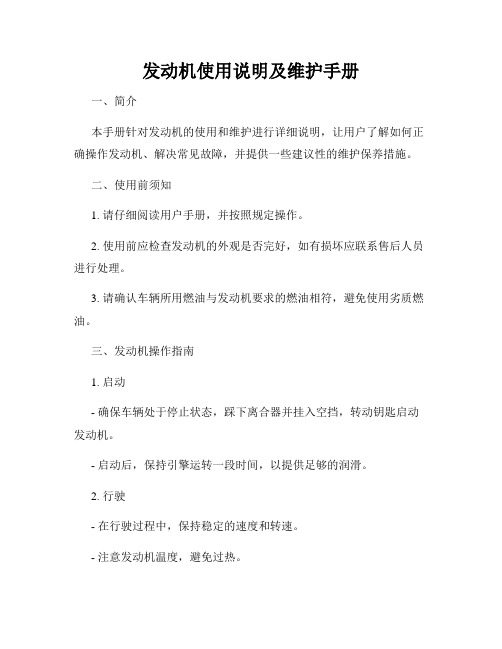
发动机使用说明及维护手册一、简介本手册针对发动机的使用和维护进行详细说明,让用户了解如何正确操作发动机、解决常见故障,并提供一些建议性的维护保养措施。
二、使用前须知1. 请仔细阅读用户手册,并按照规定操作。
2. 使用前应检查发动机的外观是否完好,如有损坏应联系售后人员进行处理。
3. 请确认车辆所用燃油与发动机要求的燃油相符,避免使用劣质燃油。
三、发动机操作指南1. 启动- 确保车辆处于停止状态,踩下离合器并挂入空挡,转动钥匙启动发动机。
- 启动后,保持引擎运转一段时间,以提供足够的润滑。
2. 行驶- 在行驶过程中,保持稳定的速度和转速。
- 注意发动机温度,避免过热。
3. 熄火- 停车前,请将发动机处于怠速运转一段时间,以保证发动机正常冷却。
- 确保发动机处于熄火状态后方可锁车离开。
四、日常维护保养1. 机油更换- 根据使用手册规定的公里数或时间周期,定期更换机油。
- 更换机油时,应先排除旧油,再加入新油,注意不要添加过多或过少。
2. 空气滤清器清洁- 定期清洗或更换空气滤清器以保持空气的流通。
- 清洁滤清器时,应按照说明书上的指示进行操作。
3. 防冻液添加- 维持适量的冷却液可以保持发动机在正常温度范围内运行。
- 防冻液的添加量应符合规定的比例。
4. 火花塞更换- 提前更换老化的火花塞可以保证点火正常,减少燃油消耗。
- 更换火花塞时,应选择合适的型号。
5. 电瓶维护- 定期检查电瓶的电量和连接情况。
- 如发现电量不足,可及时充电或更换电瓶。
五、故障排除1. 故障判断- 发动机出现异常噪音、冒烟、漏油等情况时,应及时停车,查明故障原因。
- 如无法判断故障原因,请联系专业人员进行检修。
2. 常见故障处理- 水温过高:停车检查散热系统,清洗或更换散热器。
- 油量不足:补充燃油。
- 电路故障:检查电瓶连接是否松动,如有问题请联系维修人员。
- 发动机漏油:查找漏油点,及时更换密封圈或相关零件。
六、注意事项1. 长时间停车时,应将发动机熄火,并关闭车辆的电源系统。
车辆动力系统技术手册
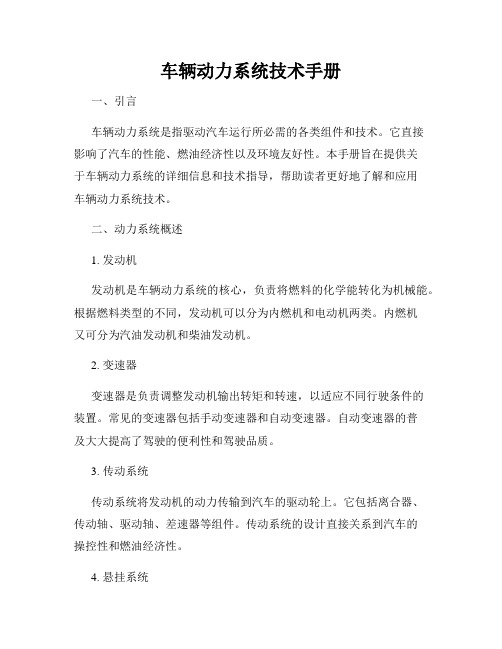
车辆动力系统技术手册一、引言车辆动力系统是指驱动汽车运行所必需的各类组件和技术。
它直接影响了汽车的性能、燃油经济性以及环境友好性。
本手册旨在提供关于车辆动力系统的详细信息和技术指导,帮助读者更好地了解和应用车辆动力系统技术。
二、动力系统概述1. 发动机发动机是车辆动力系统的核心,负责将燃料的化学能转化为机械能。
根据燃料类型的不同,发动机可以分为内燃机和电动机两类。
内燃机又可分为汽油发动机和柴油发动机。
2. 变速器变速器是负责调整发动机输出转矩和转速,以适应不同行驶条件的装置。
常见的变速器包括手动变速器和自动变速器。
自动变速器的普及大大提高了驾驶的便利性和驾驶品质。
3. 传动系统传动系统将发动机的动力传输到汽车的驱动轮上。
它包括离合器、传动轴、驱动轴、差速器等组件。
传动系统的设计直接关系到汽车的操控性和燃油经济性。
4. 悬挂系统悬挂系统对车辆的平稳性、舒适性和操控性起着重要作用。
它由减震器、弹簧、悬臂等构成,能够吸收路面震动,提供稳定的车辆悬挂效果。
5. 制动系统制动系统用于减速和停车,是车辆安全性的重要保障。
常见的制动系统包括盘式刹车和鼓式刹车,还有辅助制动系统如制动助力器等。
三、发动机技术1. 汽油发动机技术汽油发动机是目前主流的发动机种类,采用汽油作为燃料。
随着技术的进步,先进的汽油发动机采用了缸内直喷、涡轮增压等技术,提高了燃烧效率和动力输出。
2. 柴油发动机技术柴油发动机以柴油为燃料,具有高燃烧效率和较低的燃油消耗。
近年来,柴油发动机在减排和噪声控制等方面也有了显著的改进。
3. 混合动力技术混合动力系统将内燃机和电动机相结合,实现了更高的燃油经济性和更低的尾气排放。
采用了回收制动能量及启停系统等技术,混合动力系统是未来汽车发展的趋势。
四、变速器技术1. 手动变速器技术手动变速器是传统的变速器类型,由驾驶员手动操作换挡。
它简单可靠,同时也可以提供更高的操控乐趣。
2. 自动变速器技术自动变速器提供了更便捷的驾驶方式,驾驶员无需手动操作换挡。
SJ486发动机动力系统用户手册(单动力系统)
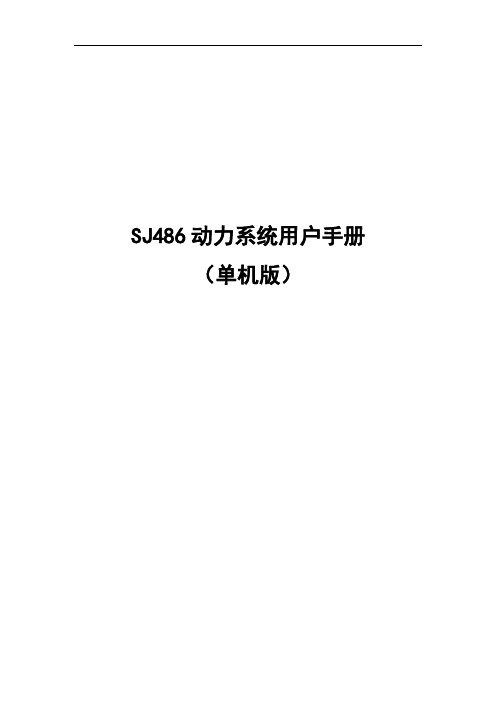
SJ486动力系统用户手册(单机版)敬告用户感谢您对SJ486动力系统的青睐。
本操作说明书向您详尽的介绍了如何正确操作、维护及保养。
使用前请认真阅读并理解本操作说明书。
如您在操作及维护方面出现任何疑问,请向湖北三江船艇科技有限公司经销商咨询。
注意:本说明书由湖北三江船艇科技有限公司于2014年11月编制,版权由湖北三江船艇科技有限公司所有,未经湖北三江船艇科技有限公司书面许可,严禁翻印或使用。
此说明书仅供参考,不明之处由湖北三江船艇科技有限公司负责解释。
重要说明本说明书中,◆表示特别重要信息;涉及到您人身安全的警告信息,需引起注意。
▲表示警告、安全信息,如不遵循本警告,可能会对驾驶员、乘客、周围人群、检查或修理人员造成重伤或死亡。
一、产品简介 (1)1、基本信息 (2)1.1 产品简介 (2)1.2 产品标识 (2)2、产品信息 (4)2.1 适用范围 (4)2.2 重要信息 (4)二、技术规格及性能参数 (5)1、发动机 (6)1.1发动机基本尺寸 (6)1.2冷却系统基本构造 (7)1.3发动机性能参数 (2)2、燃料系统 (3)2.1 燃料系统组成 (3)2.2 燃油泵 (4)2.3 燃油泵压板 (5)3、电气系统 (6)3.1 ECU (6)3.2保险丝盒组件 (7)3.3多功能仪表 (2)3.4 遥控器和接收器 (4)3.5 油门位置传感器 (5)3.6开关 (6)3.7发动机上装配的电器件 (8)3.8 其它 (9)4、操控系统 (11)5、喷水推进系统 (13)5.1喷水推进器组成 (13)5.2喷水推进器主要尺寸 (13)5.3单动力系统喷水推进器主要性能参数 (13)6、附件 (14)6.1消声器组件 (14)6.2 轴承座组件 (14)6.3 进水拦网组件 (15)三、安装 (17)1、总体要求 (18)1.1动力系统布置示意图 (18)1.2空间要求 (18)1.3安全要求 (18)1.4进水拦网安装 (19)1.5喷水推进器安装 (21)1.6轴承座组件安装 (22)1.7消声器组件安装 (23)1.8发动机安装 (24)1.9燃油供给系统安装 (27)1.10电器件接线 (29)四、操作及使用要求 (33)1、发动机使用要求 (34)1.1检查 (34)1.2 注意事项 (35)1.3 启动发动机 (36)1.4 关闭发动机 (36)1.5 发动机磨合 (36)2、喷水推进器使用要求 (37)五、日常保养及维护 (38)1、发动机日常保养及维护 (39)1.1定期常规维护 (39)1.2冷却水道维护 (40)1.3润滑点维护 (40)1.4供油系统检查 (41)1.5更换机油 (41)1.6更换机油滤清器 (42)1.7检查空气滤清器 (42)1.8检查怠速 (43)2、电气系统日常保养及维护 (44)2.1蓄电池 (44)2.2火花塞 (44)3、喷水推进系统日常保养及维护 (46)3.2控制杆检查 (46)六、常见故障诊断及处理 (47)1.发动机的故障诊断 (48)2.仪表上的故障报警显示 (49)2.1仪表故障显示 (49)2.2仪表自诊断功能 (50)3.更换保险丝 (51)4.喷水推进器故障处理 (52)附图一多功能仪表 (53)附图二电气原理图 (54)一、产品简介1、基本信息1.1 产品简介本动力系统总成主要由燃料系统、操控系统、SJ486发动机、电气设备、喷水推进器及附件6大部分组成。
发动机使用说明书

发动机使用说明书D7A T/TA船用发电机组控制系统MCC美国加利福尼亚州第65号提案警告柴油发动机排出的气体及其部分成分包含美国加州已知的导致癌症、出生缺陷或其他生殖系统受损的物质。
前言十分感谢您购买本Volvo Penta船用发电机组。
本说明书包含操作指示信息以及维护和检查信息。
为了保证安全并充分利用该发电机组的性能,在阅读并完全掌握本说明书的内容之前,请不要运行该发电机组。
另外,如果不符合当地犯规的要求,也请不要运行该发电机组。
有关发电机特定部件的信息,请参阅发电机制造商提供的发电机信息。
如果存在冲突,本Volvo Penta说明书中的信息将替代发电机制造商提供的文件中给出的任何信息。
请立即向您的Volvo Penta经销商进行咨询。
如不遵守本说明书中的指示信息和警告信息,可能会导致发生严重事故。
*请随身携带本说明书以便于参考。
*如果本说明书已损坏或者丢失,请立即从您的经销商处订购一本新的说明书。
本说明书中的所有信息和示意图都基于印刷时可用的产品规格。
本说明书并不完全包括所有附件和选件的各种变型。
目录安全信息.....................................................5燃油系统 (46)发动机操作中的安全规则.............................6燃油系统排气 (46)维护保养和操作中的安全说明更换燃油滤清器 (46)47简介..............................................................10燃油粗滤器/油水分离器................................经认证的发动机...........................................11空气进气和排气系统 (49)保修.............................................................11更换空气滤清器.. (49)技术说明.......................................................12清洁空气压缩机 (49)D7A T HE....................................................12检查增压空气冷却器的排气孔.. (49)D7A TA HE.................................................13冷却系统一般信息. (50)D7A T RC....................................................14淡水系统.. (57)D7A T KC(1条管路)..................................15检查冷却液液位.. (57)D7A TA KC(11/2管电路).........................16灌充冷却液 (57)D7A TA KC(2条管路)..............................17排空冷却液 (58)新发电机组初始维护....................................18冲洗淡水系统.. (58)启动..............................................................19海水系统.. (59)船用商用控制系统.........................................21排空海水系统.. (59)MCC系统概述..............................................22海水泵. (59)MCU面板布局..............................................23发动机上安装的热交换器 (61)菜单.............................................................26电气系统.. (62)操作.............................................................28检查电气布线.. (62)MCU菜单流程图..........................................29主开关. (62)设定点.......................................................31熔断器. (62)关闭系统概述................................................32电焊.. (62)SDU示意图..................................................33蓄电池充电 (64)65操作............................................................34封存...............................................................67停止发动机...................................................35故障诊断.......................................................紧急停机......................................................35技术数据.. (68)停止发动机后..............................................35D7A T HE.. (68)防冻措施......................................................36D7A TA HE.. (69)操作中中断[不使用发电机组]....................36D7A T RC. (70)D7A T KC(1条管路) (71)维护保养.......................................................37D7A TA KC(11/2管路) (72)日常操作记录的建议..................................38D7A TA KC(2条管路). (73)维护保养计划................................................39燃油规格 (74)润滑油规格 (75)发动机...........................................................41冷却液规格. (76)驱动皮带......................................................41发动机编号 (77)阀门间隙 (42)记事本 (78)润滑系统 (44)灌充润滑油 (44)更换润滑油 (44)更换润滑油滤清器 (45)安全信息请仔细阅读本章。
现代汽车发动机规格说明说明书

Hyundai Tucson. Specifications.Weight 2.0 GDi 2WD 1.6 T-GDi AWD 2.0 CRDi AWDManual Automatic DCT AutomaticKerb weight - lightest 1467 kg1490 kg1561 kg1656 kgKerb weight - heaviest1566 kg1590 kg1666 kg1769 kgGross Vehicle Mass (GVM)2040 kg2060 kg2150 kg2250 kg Permissible Axle Weight (PAW) - front1240 kg1240 kg1240 kg1240 kg Permissible Axle Weight (PAW) - rear1150 kg1150 kg1150 kg1150 kgRoof rack load limit100 kg100 kg100 kg100 kgTowing capacity 2.0 GDi 2WD 1.6 T-GDi AWD 2.0 CRDi AWDManual Automatic DCT AutomaticBraked1600 kg1600 kg1600 kg1600 kgUnbraked750 kg750 kg750 kg750 kgMaximum towball weight120 kg120 kg140 kg140 kgFuel consumption* 2.0 GDi 2WD 1.6 T-GDi AWD 2.0 CRDi AWDManual Automatic DCT Automatic Combined (L/100km)7.87.97.7 6.4Urban (L/100km)10.611.09.68.0Extra Urban (L/100km) 6.2 6.1 6.5 5.4CO2 - combined (g/km)182185178168Fuel tank volume62 L*Source: Australian Design Rule 81/02 static laboratory combined average city and highway cycle test. Real world fuel consumption will vary depending on a combination of driving habits, the condition of the vehicle, and other factors such as road, traffic and weather conditions. ADR 81/02 test results are meant for comparison purposes only.Dimensions Active Active X Elite HighlanderExteriorLength4480 mmWidth1850 mmHeight (with roof rails)1655 mm (1660 mm)Wheelbase2670 mmWheel track - front / rear1608 mm / 1620 mm1608 mm / 1620 mm1608 mm / 1620 mm1604 mm / 1615 mm Minimum ground clearance(based on kerb weight) 172 mmApproach / departure / ramp break overangle17.9º / 24.5º / 19.5ºInteriorHead room front / rear (w/ Sunroof)1005 / 995 mm (963 / 969 mm)Leg room front / rear1053 - 1129 / 970 mmShoulder room front / rear1450 / 1410 mmHip room front / rear1413 / 1384 mmCargo area - VDA (minimum / maximum)488 L / 1478 LWheels & tyres Active Active X Elite HighlanderWheel type Alloy Alloy Alloy AlloyWheel dimensions17 x 7.0J +5118 x 7.0J +5118 x 7.0J +5119 x 7.5J +53Tyre dimensions225/60 R17 99H225/55 R18 98H225/55 R18 98H245/45 R19 98HSpare wheel type Full size alloy Full size alloy Full size alloy Full size alloyDriving convenience Active Active X Elite HighlanderCruise control●●●●Electronic Parking Brake (EPB)(with auto hold function)--●●One touch turn signal - 3, 5, or 7 flashes●●●●Rain sensing wipers--●●Rear wiper - 2-stage, with auto wipeon reverse ●●●●Smart Key with push button start--●●Steering wheel mounted controls - audio,phone, cruise control & trip computer●●●●Tilt & telescopic steering column●●●●Driving engagement Active Active X Elite HighlanderDrive Mode - 3 settings(Comfort, Eco, Sport)--●1●1Active safety Active Active X Elite Highlander Electronic Stability Control (ESC) including;Anti-lock Braking System (ABS)●●●●Brake Assist System (BAS)●●●●Electronic Brakeforce Distribution (EBD)●●●●Downhill Brake Control (DBC)●●●●Hill-start Assist Control (HAC)●●●●Traction Control System (TCS)●●●●Vehicle Stability Management (VSM) ●●●●Hyundai SmartSense ™ including;Blind-Spot Collision Warning (BCW)--●●Driver Attention Warning (DAW)●2●2●●Forward Collision-Avoidance Assist (FCA) -City/Urban (camera)●2●2--Active safety Active Active X Elite Highlander Forward Collision-Avoidance Assist (FCA) ---●●City/Urban/Interurban/Pedestrian(camera & radar)High Beam Assist (HBA)--●●Lane Keeping Assist (LKA)●●●●Rear Cross-Traffic Collision Warning (RCCW)--●●Smart Cruise Control with Stop & Go(SCC w/ S&G)--●●Other featuresEmergency Stop Signal (ESS)●●●●Park Assist System (PAS) - front(4 sensors, with guidance display)---●Park Assist System (PAS) - rear(4 sensors, with guidance display)●●●●Rear view camera with dynamic guide lines●●●●Tyre Pressure Monitoring System (TPMS) -individual tyre pressure readout--●●Passive safety Active Active X Elite Highlander AirbagsFront airbags - driver & front passenger●●●●Side (thorax) airbags - driver & frontpassenger●●●●Side curtain airbags - 1st & 2nd rows●●●●Roll-over Sensor●●●●DoorsImpact sensing auto door unlock●●●●Rear door child safety locks●●●●SeatbeltsPretensioners, load limiters & heightadjustable upper mounts on front seat belts●●●●Seat belt reminder - front & rear seatbelts●●●●Seat belt holder - 2nd row●●●●SeatingHeight adjustable front head restraints withtilt function●●●●Height adjustable rear head restraints●●●●ISOFIX child restraint anchors (rearoutboard seats)●●●●Top tether child restraint anchors (rear) -3 anchors●●●●Security Active Active X Elite Highlander Security systemActive lock/unlock operation (user configurable)●●●●Anti-theft alarm●●●●Central locking●●●●Engine immobiliser●●●●RemotesKeyless entry remote - 2x●●--Smart Key remote - 2x--●●Multimedia system Active Active X Elite Highlander FunctionsApple CarPlay3 & Android Auto4compatibility●●●●Bluetooth phone connectivity●●●●Satellite navigation -●●●SUNA™ Live Traffic Updates-●●●Touch screen - 7" display●---Touch screen - 8" display-●●●SpeakersAudio system - 6 speakers●---Infinity™ premium audio system -8 speakers with external amplifier-●●●Audio/media sourcesAM/FM radio●●●●Digital radio (DAB+)-●●●Radio Data System (RDS)●●●●AUX / USB audio input with iPod®compatibility●●●●Bluetooth audio streaming●●●●Occupant comfort & convenience Active Active X Elite Highlander Upholstery/trimLeather5 appointed interior - steering wheel& gear knob●---Leather5 appointed interior - seats, steeringwheel & gear knob-●●●Occupant comfort & convenience Active Active X Elite Highlander Front seatsDriver's seat - height adjustable●●●●Driver's seat - manually adjustable withpower adjustable lumbar support - 2-way-●--Driver's seat - power adjustable - 10-way(including 2-way lumbar support) --●●Passenger's seat - power adjustable - 8-way---●Front centre console bolster - driver's side---●Front centre console storage cubby - poweroutlet - 1 x 12V outlet ●●●●Front centre console - wireless chargingpad (Qi standard)6---●Grip handles - 1x (passenger)●●●●Rear seatsCentre fold down armrest●●●●Grip handles - 2x●●●●Rear centre console - USB power outlet-●●●Windows/shadesAcoustic laminated windshield glass●●●●Panoramic glass sunroof - dual panel withtilt and slide front panel and power sunblind---●Power windows - front & rear●●●●One touch window up & down function withanti-pinching safety feature - driver's window●●●●Solar control glass ---●Rear privacy glass--●●Sunvisor extensions - driver and frontpassenger●●●●Doors/boot/tailgateLuggage area power outlet - 1 x 12V outlet ●●●●Smart Tailgate (rear power tailgate withhands-free opening)---●Vision & sight Active Active X Elite Highlander Interior mirrorElectro-chromatic Mirror (ECM) -auto-dimming with integrated compass---●Exterior mirrorsHeated-●●●Power adjustable ●●●●Power folding with auto fold function-●●●Instrument cluster/driving displaysInstrument cluster - 3.5" TFT LCD with tripcomputer & digital speedometer●●●-Supervision cluster - 4.2" TFT colour LCDwith trip computer & digital speedometer---●Ventilation & heating Active Active X Elite Highlander Air conditioningClimate control - dual zone----Climate control - dual zone with auto defogfunction--●●Manual controls●●--Cabin air filter ●●●●Cluster ioniser (clean air function)--●●Cooling/heating vents - rear centre console--●●Cooling/heating vents - rear floor●●●●Front seatsAir ventilated front seats---●Heated front seats---●Other featuresGlovebox cooling--●●Heated rear windshield●●●●Heated steering wheel---●Exterior styling Active Active X Elite Highlander FrontFront grille - matte black●●--Front grille - glossy black--●●Front grille surround - matte grey●●--Front grille surround - chrome--●●Front grille inserts - chrome--●●Skid plate - matte grey---●SideDoor frame & beltline moulding - chrome --●●Exterior door handles - chrome--●●Side garnish insert - matte grey--●●RearDual exhaust tips - chrome ---●Spoiler - body coloured, tailgate mounted ●●●●Skid plate - matte grey---●Interior styling Active Active X Elite Highlander TreatmentsAlloy effect inserts (steering wheel andtransmission gear knob)●●●●Alloy effect surrounds (air vents)●●●●Alloy effect garnish - power window switches--●●MaterialsPremium materials - dashboard centre trim●●●●Premium materials - door centre trim●●●●Lighting Active Active X Elite Highlander Exterior lighting - frontFog lights●●●●Daytime Running Lights (DRL) - LED●●●●Headlight functions - automatic dusksensing with escort and welcome●●●●Headlight type - LED (low/high beam)---●Headlight type - projector beam●●●-Positioning lights - LED●●●●Static bending lights - LED---●Exterior lighting - rearFog lights●●●●High Mount Stop Light (HMSL) - LED●●●●Rear combination lights - LED (bulbindicator and reverse lights)---●Exterior lighting - othersCourtesy lights - LED, in front door handles--●●Puddle lights - LED, in side mirrors--●●Side repeaters - LED, integrated into sidemirrors●●●●Interior lighting - frontFront room lights and map lights●●●-Front room lights and map lights - LED---●Vanity mirror lights --●●Glovebox compartment light●●●●Interior lighting - rearCentre room light●●●-Map lights (outboard) - LED---●Interior lighting - othersCargo area light●●●●Interior light fade-out delay●●●●Safety reflectors - integrated in doors (front)●●●●Storage solutions Active Active X Elite Highlander Front seatsCentre console - deluxe type--●●Cup holders - centre console ●●●●Front seat back pockets●●●●Glovebox compartment●●●●Retractable sunglasses compartment●●●●Ticket holders - sunvisors(driver and front passenger)●●●●Rear seatsCoat hooks - 3x●●●●Cup holders - armrest●●●●Rear seating split folding - 60 :40●●●●Boot/Luggage areaBag hooks - 1x●●●●Cargo cover - retractable with 2 positionsetting●●●●Luggage compartment - 6x mounting points●●●●Luggage net --●●Underfloor side storage recess●●●●OthersDoors - map pockets and bottle bulges(front and rear)●●●●Centre console - map pocket (passengersside)●●●●Roof Rails●●●●Notes:1. Drive mode select only available on 1.6 T-GDi and2.0 CRDi variants of Elite and Highlander.2. Feature not available on manual transmission variants.3. Apple CarPlay requires iPhone 5 or subsequent model (lightning cable) in order to operate.4. Android Auto requires a device with Android5.0 operating system or subsequent version in order to operate.5. Finishes specified as leather may contain elements of genuine leather, polyurethane leather (leather substitute) or man-made materials, or a combination thereof.6. Wireless charging requires a Qi-enabled smartphone or adapter in order to operate.Key:● = Feature is available on trim- = Feature is not available on trim。
- 1、下载文档前请自行甄别文档内容的完整性,平台不提供额外的编辑、内容补充、找答案等附加服务。
- 2、"仅部分预览"的文档,不可在线预览部分如存在完整性等问题,可反馈申请退款(可完整预览的文档不适用该条件!)。
- 3、如文档侵犯您的权益,请联系客服反馈,我们会尽快为您处理(人工客服工作时间:9:00-18:30)。
1850+4000+1350
4100+1350
华菱重卡发动机经全面升级后功率分级更合理、覆盖面更广、动力更强劲、
油耗更经济:目前进口的可选装日本三菱、五十铃、美国康明斯,功率覆盖范 围从300-450马力。国产可以选装
康明斯 C系列
:280马力-300马力
L系列
:280马力-375马力
EQB系列
:170马力-210马力
②、配气机构 组成:气门、气门弹簧、凸轮轴、挺杆、摇臂、凸轮轴传动机构等组件
配气机构示意图
功能:配气机构的功用 是根据发动机的工作顺 序和工作过程,定时开 启和关闭进气门和排气 门,使可燃混合气或空 气进入气缸,并使废气 从气缸内排出,实现换 气过程
③、燃料供给系统
组成:由油箱、油泵、柴油滤清器等组成。电控燃油喷射式由空气供给系统、 燃油供给系统和电子控制系统组成。
4.柴油发动机的组成
柴油机由以上两大机构和四大系统组成,即由曲柄连杆机构、 配气机构、燃 料供给系、润滑系、冷却系和起动系组成。
发 动 机 整 体 透 视 图
华菱用潍柴发动机构造示意图
华 菱 用 康 明 斯 发 动 机 构 造 示 意 图
①﹑曲柄连杆机构 组成:汽缸体、汽缸盖、活塞、连杆曲轴和飞轮等机件
ISDE系列
: 185马力-270马力
ISZ系列
: 425马力-525马力
潍柴: WD615系列
:260马力-380马力
WP10N系列
:240马力-375马力
WP12系列
:290马力-460马力
玉柴: YC6L系列
:260马力-330马力
YC6A系列
:240马力-310马力
YC6J系列
:160马力-230马力
功能: 曲柄连杆机构是发动机实现工 作循环,完成能量转换的主要运动零 件。它由机体组、活塞连杆组和曲轴 飞轮组等组成。在作功行程中,活塞 承受燃气压力在气缸内作直线运动, 通过连杆转换成曲轴的旋转运动,并 从曲轴对外输出动力。而在进气、压 缩和排气行程中,飞轮释放能量又把 曲轴的旋转运动转化成活塞的直线运 动。
图: 狄塞尔发动机和他发明的柴油机
柴油发动机的优点是功率大、经济性能好。柴油发动机的工作过程与汽油发 动机有许多相同的地方,每个工作循环也经历进气、压缩、做功、排气四个行程。 但由于柴油机用的燃料是柴油,其粘度比汽油大,不易蒸发,而其自燃温度却较汽 油低,因此可燃混合气的形成及点火方式都与汽油机不同。不同之处主要是,柴油 发动机气缸中的混合气是压燃的,而不是点燃的。柴油发动机工作时进入气缸的是 空气,气缸中的空气压缩到终点时,温度在500-700℃,压力40—50个大气压。活 塞接近上止点时,发动机上的高压泵以高压向气缸中喷射柴油,柴油形成细微的油 粒,与高压高温的空气混合,柴油混合气自行燃烧,猛烈膨胀,产生爆发力,推动 活塞下行做功。此时的温度可1900-2000摄氏度,压力可达60-100个大气压,功率 很大,所以,柴油发动机广泛的应用于大型柴油汽车上。
YC6J系列
:230马力-270马力
YC6A系列
:240马力-260马力
一、发动机
1.柴油发动机概述: 柴油发动机是燃烧柴油来获取能量释放的发动机。它是由德国发明家鲁
道夫·狄塞尔(RudolfDiesel)于1892年发明的,为了纪念这位发明家,柴油 就是用他的姓Diesel来表示,而柴油发动机称为狄塞尔发动机 。
意 适宜的温度状
图 态下工作。
⑥、润滑系统 组成:由机油泵、集滤器、限压阀、油道、机油滤清器等组成。
功能:润滑系的
润 滑
功用是向作相对 运动的零件表面
系 输送定量的清洁
统 润滑油,以实现
示 意 图
液体摩擦,减小 摩擦阻力,减轻
机件的磨损。并
对零件表面进行
清洗和冷却。
⑦、起动系统 组成:由起动机及其附属装置组成。
3.柴油发动机的分类
● 按用途可分为: 工程机械配套柴油发动机 农用机械配套柴油发动机 井下设备配套柴油发动机 车辆配套柴油发动机 叉车配套柴油发动机 压缩机配套柴油发动机 发电机组,焊机,泵配套柴油发动机 船机配套柴油发动机
● 按排量缸数可分为: 2 、 3 、 4 、5 、 6 、 8 、 10 、 12 缸 华菱汽车所采用的是车辆配套6缸、增压、空空中冷型柴油发 动机。
2. 柴油发动机的特点:
热效率和经济性较好,柴油机采用压缩空气的办法提高空气温度,使空气温度 超过柴油的自燃燃点,这时再喷入柴油、柴油喷雾和空气混合的同时自己点火燃烧。 因此,柴油发动机无需点火系。同时,柴油机的供油系统也相对简单,因此柴油发 动机的可靠性要比汽油发动机要好。由于不受爆燃的限制以及柴油自燃的需要,柴 油机压缩比很高。热效率和经济性都要好于汽油机,同时在相同功率的情况下,柴 油机的扭矩大,最大功率时的转速低,适合于载货汽车的使用。
1850+4800+1350 850+5310+1350 1850+5800+1350 1
自卸车: 4X2 3800 4800 5100
6X2 1850+3870
1850+4250
6X4 3200+1350
3600+1350
4400+1350
4700+1350
8X4 1850+4605+1350
1850+3370+1350
发动机系统说明书
华菱重型汽车经过五年多的发展,现已形成体系完备、质量成熟、性能稳定、 品种齐全的系列化产品。产品主要包括星凯马系列、华菱重卡系列、华菱之星系 列。目前公司产品轴距分布广泛: 牵引车: 6X4: 3200+1350
6X2: 1850+2600 1940+2510 4X2: 3400 载货车: 4X2: 5600 6X4 : 4100 +1350 5220+1350 5850+1350 6X2: 1850+4800 1850+5800 1850+4250 8X4: 1850 +4605+1350
功能:柴油
机燃料供给系
燃 的功用是把柴
油 油和空气分别
系 供入气缸,在
统 燃烧室内形成
示 意 图
混合气并燃烧, 最后将燃烧后
的废气排出。
④、冷却系统 组成:水冷式由水套、水泵、散热器、风扇、节温器等组成。
发 动
功能:冷却系
机 的功用是将受
冷 热零件吸收的ห้องสมุดไป่ตู้
却 系 统
部分热量及时 散发出去,保
示 证发动机在最
